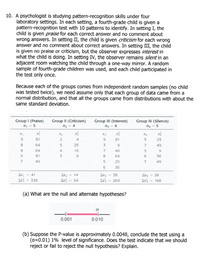
MATLAB: An Introduction with Applications
6th Edition
ISBN: 9781119256830
Author: Amos Gilat
Publisher: John Wiley & Sons Inc
expand_more
expand_more
format_list_bulleted
Question
thumb_up100%
BADLY NEED SOLUTIONS FOR THIS!

Transcribed Image Text:10. A psychologist is studying pattern-recognition skills under four
laboratory settings. In each setting, a fourth-grade child is given a
pattern-recognition test with 10 patterns to identify. In setting I, the
child is given praise for each correct answer and no comment about
wrong answers. In setting II, the child is given criticism for each wrong
answer and no comment about correct answers. In setting III, the child
is given no praise or criticism, but the observer expresses interest in
what the child is doing. In setting IV, the observer remains silent in an
adjacent room watching the child through a one-way mirror. A random
sample of fourth-grade children was used, and each child participated in
the test only once.
Because each of the groups comes from independent random samples (no child
was tested twice), we need assume only that each group of data came from a
normal distribution, and that all the groups came from distributions with about the
same standard deviation.
Group I (Praise)
Group II (Criticism)
Group III (Interest)
Group IV (Silence)
n, = 5
n2 = 4
n3 = 6
n4 = 5
X1
X2
x3
X3
X4
6.
81
4
9.
81
25
8
64
25
6.
7
49
8
64
16
49
9.
6.
81
9.
8.
64
6.
36
49
25
7.
49
6.
36
Ex1
= 41
Ex2
= 14
Ex3
= 38
EX4
28
339
54
= 264
= 168
(a) What are the null and alternate hypotheses?
0.001
0.010
(b) Suppose the P-value is approximately 0.0048, conclude the test using a
(a=0.01) 1% level of significance. Does the test indicate that we should
reject or fail to reject the null hypothesis? Explain.
1254 3
Expert Solution
This question has been solved!
Explore an expertly crafted, step-by-step solution for a thorough understanding of key concepts.
Step by stepSolved in 3 steps

Knowledge Booster
Similar questions
- Please show detailed step-by-step explanation and solution for each problem (problem #2, problem #3, problem #4, problem #5, and problem #6). Please use the results of problems #2 and problems #3 to solve and show your work for problems #5 and problems #6 (just like the hint stated).arrow_forwardPlease solve each of these problemsarrow_forwardI need help with both!!!arrow_forward
- This question has several parts that must be completed sequentially. If you skip a part of the question, you will not receive any points for the skipped part, and you will not be able to come back to the skipped part. A person's lean body weight L is the amount he or she would weigh if all body fat were magically to disappear. One text gives the "equation that practitioners can use most feasibly in the field to predict lean body weight in young adult males." The equation is found below. L = 98.42 + 1.08W − 4.14A Here L is lean body weight in pounds, W is weight in pounds, and A is abdominal circumference in inches. Find the approximate lean body weight of a young adult male who weighs 181 pounds and has an abdominal circumference of 41 inches. What is the weight of his body fat? What is his body fat percent?arrow_forwardPlease help on all the parts of the problem!!arrow_forwardurgent.arrow_forward
arrow_back_ios
arrow_forward_ios
Recommended textbooks for you
 MATLAB: An Introduction with ApplicationsStatisticsISBN:9781119256830Author:Amos GilatPublisher:John Wiley & Sons Inc
MATLAB: An Introduction with ApplicationsStatisticsISBN:9781119256830Author:Amos GilatPublisher:John Wiley & Sons Inc Probability and Statistics for Engineering and th...StatisticsISBN:9781305251809Author:Jay L. DevorePublisher:Cengage Learning
Probability and Statistics for Engineering and th...StatisticsISBN:9781305251809Author:Jay L. DevorePublisher:Cengage Learning Statistics for The Behavioral Sciences (MindTap C...StatisticsISBN:9781305504912Author:Frederick J Gravetter, Larry B. WallnauPublisher:Cengage Learning
Statistics for The Behavioral Sciences (MindTap C...StatisticsISBN:9781305504912Author:Frederick J Gravetter, Larry B. WallnauPublisher:Cengage Learning Elementary Statistics: Picturing the World (7th E...StatisticsISBN:9780134683416Author:Ron Larson, Betsy FarberPublisher:PEARSON
Elementary Statistics: Picturing the World (7th E...StatisticsISBN:9780134683416Author:Ron Larson, Betsy FarberPublisher:PEARSON The Basic Practice of StatisticsStatisticsISBN:9781319042578Author:David S. Moore, William I. Notz, Michael A. FlignerPublisher:W. H. Freeman
The Basic Practice of StatisticsStatisticsISBN:9781319042578Author:David S. Moore, William I. Notz, Michael A. FlignerPublisher:W. H. Freeman Introduction to the Practice of StatisticsStatisticsISBN:9781319013387Author:David S. Moore, George P. McCabe, Bruce A. CraigPublisher:W. H. Freeman
Introduction to the Practice of StatisticsStatisticsISBN:9781319013387Author:David S. Moore, George P. McCabe, Bruce A. CraigPublisher:W. H. Freeman

MATLAB: An Introduction with Applications
Statistics
ISBN:9781119256830
Author:Amos Gilat
Publisher:John Wiley & Sons Inc

Probability and Statistics for Engineering and th...
Statistics
ISBN:9781305251809
Author:Jay L. Devore
Publisher:Cengage Learning

Statistics for The Behavioral Sciences (MindTap C...
Statistics
ISBN:9781305504912
Author:Frederick J Gravetter, Larry B. Wallnau
Publisher:Cengage Learning

Elementary Statistics: Picturing the World (7th E...
Statistics
ISBN:9780134683416
Author:Ron Larson, Betsy Farber
Publisher:PEARSON

The Basic Practice of Statistics
Statistics
ISBN:9781319042578
Author:David S. Moore, William I. Notz, Michael A. Fligner
Publisher:W. H. Freeman

Introduction to the Practice of Statistics
Statistics
ISBN:9781319013387
Author:David S. Moore, George P. McCabe, Bruce A. Craig
Publisher:W. H. Freeman